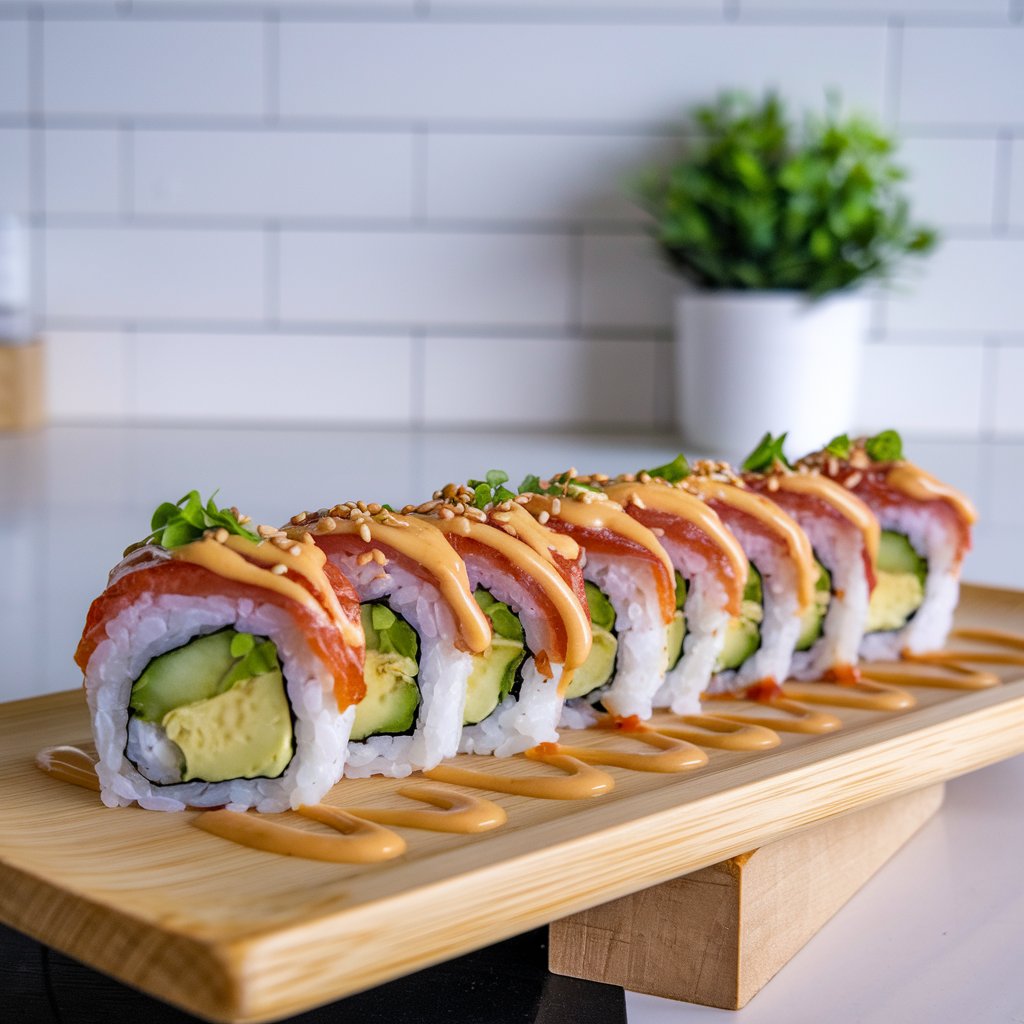Dragon Rolls
Are you ready to elevate your sushi game? Meet the dragon roll recipe, one of the most iconic and delicious sushi creations ever. Imagine a roll filled with crispy shrimp tempura, creamy avocado, and crunchy cucumber, all wrapped in sushi rice and topped with more avocado slices and a drizzle of eel sauce. Sounds fancy? Don’t worry—you can recreate this dragon roll recipe masterpiece in your own kitchen!
Whether you’re a sushi newbie or a seasoned pro, this guide will walk you through every step of making a dragon roll recipe from scratch. Plus, we’ll tackle common problems and share helpful tips so your dragon roll recipe looks and tastes like it came from a top sushi bar.
What is a Dragon Roll?
The Essence of a Dragon Roll
The dragon roll recipe is a type of sushi roll (maki) that’s all about flavor and presentation. Its signature look—a vibrant green “dragon-like” appearance—is thanks to the thin slices of avocado layered on top. Inside the dragon roll recipe, you’ll find shrimp tempura, cucumber, and sometimes crab meat. The roll is often topped with eel sauce, which adds a sweet and savory kick.
Origin and Popularity
Why the name “dragon roll recipe”? The design resembles a dragon’s scales, giving it an iconic, eye-catching appearance, and its ingredients symbolize power and luxury in Japanese culture. While traditional sushi focuses on simplicity, the dragon roll recipe embraces creativity with bold flavors and artistic presentation. Today, it’s a hit worldwide, often featuring unique variations like spicy mayo, tobiko (fish roe), or even alternative fillings to suit different tastes.
Why Make Dragon Rolls at Home?
Making dragon rolls at home isn’t just fun—it’s rewarding. You control the ingredients, customize the fillings, and save a ton of money compared to restaurant prices. Plus, rolling sushi is a great skill to show off to your family and friends.
Ingredients Needed for Dragon Rolls
Let’s talk about the building blocks of a perfect dragon roll. The quality of your ingredients can make or break your sushi.
Essential Ingredients
Here’s what you’ll need:
- Sushi Rice: Short-grain rice seasoned with vinegar, sugar, and salt.
- Shrimp Tempura: Crispy fried shrimp adds texture and flavor.
- Cucumber: Thinly sliced for a refreshing crunch.
- Avocado: Ripe and creamy, both inside and on top.
- Nori (Seaweed Sheets): Holds everything together.
- Eel Sauce: A sweet and savory sauce for drizzling.
Optional Toppings and Variations
Want to get creative? Try adding:
- Tobiko (Fish Roe): For a pop of color and texture.
- Spicy Mayo: A kick of heat.
- Crab Stick: Extra sweetness inside.
Where to Source Quality Ingredients
You can find most of these items at Asian grocery stores or online. For the freshest avocado and cucumber, stick to your local produce market. Sushi-grade shrimp and nori can also be sourced from specialty food stores.
Tools and Equipment for Making Dragon Rolls
Making sushi is an art, but having the right tools makes it easier.
Must-Have Sushi Tools
- Bamboo Rolling Mat (Makisu): Essential for rolling sushi tightly.
- Sharp Knife: A must for cleanly slicing the roll.
- Plastic Wrap: Helps prevent the avocado from sticking during rolling.
Substitutes for Specialized Equipment
No bamboo mat? Use parchment paper instead. A non-stick spatula can also work for spreading rice evenly. The key is improvisation—don’t let missing tools stop you from making your dragon roll!
Pro Tip: Always keep a small bowl of water mixed with rice vinegar nearby. Wetting your hands and tools prevents sticking and ensures a smoother process.
How to Prepare for Dragon Roll Assembly
Before you start rolling, preparation is key. Think of it as setting up your sushi-making station like a chef’s mise en place—it saves time and makes the process smoother.
Preparing the Sushi Rice
Sushi rice is the heart of any good roll. Here’s how to get it just right:
- Rinse the Rice: Place your rice in a bowl and rinse it under cold water until the water runs clear. This removes excess starch, ensuring fluffy rice.
- Cook the Rice: Use a rice cooker or stovetop, following a 1:1.2 rice-to-water ratio. Once cooked, let it cool for 10 minutes.
- Season the Rice: Mix rice vinegar, sugar, and salt, then gently fold it into the rice while it’s warm. Be careful not to mash the grains!
Pro Tip: Cover the rice with a damp cloth to prevent it from drying out while you prepare other ingredients.
Cutting and Preparing Vegetables
Next, prep your veggies for the roll:
- Cucumber: Peel (if desired) and cut into thin julienne strips. They should be about the length of your nori sheet.
- Avocado: Slice one half into thin strips for the roll’s topping and dice the other half for the filling. Use a spoon to scoop out the flesh to keep the slices intact.
Preparing the Shrimp Tempura
Shrimp tempura is the star of the dragon roll’s filling, and making it is simpler than you think:
- Devein and Clean the Shrimp: Remove the shells, leaving the tails intact for aesthetics. Make a shallow cut along the back and pull out the vein.
- Flatten the Shrimp: Make small cuts along the underside to prevent curling during frying.
- Batter and Fry: Dip the shrimp in tempura batter, then fry them in hot oil until golden and crispy. Place them on a paper towel to drain excess oil.
Step-by-Step Instructions for Assembling a Dragon Roll
Now comes the exciting part—assembling your dragon roll! Don’t worry; it’s easier than it looks if you follow these steps.
Rolling the Sushi Mat
- Set Up Your Station: Place a bamboo mat on your counter and cover it with plastic wrap. This keeps the mat clean and makes rolling smoother.
- Prepare the Nori: Lay one sheet of nori, shiny side down, on the mat.
Layering the Ingredients
- Spread the Rice: Wet your hands with the vinegar water mixture, then gently spread a thin layer of rice over the nori, leaving a 1-inch border on one edge.
- Flip the Nori: Carefully flip the nori so the rice faces down onto the plastic wrap.
- Add the Fillings: Arrange shrimp tempura, cucumber, and diced avocado in a line across the center of the nori.
Achieving the Perfect Dragon Shape
- Roll It Up: Use the bamboo mat to tightly roll the nori around the fillings. Start at the edge with the fillings and roll away from you, applying gentle pressure to shape the roll.
- Add the Avocado Topping: Layer thin avocado slices over the top of the roll. Use the mat to press them down gently, molding them to the roll’s shape.
- Drizzle with Sauce: Finish with a generous drizzle of eel sauce.
Pro Tip: For clean slices, wet your knife with vinegar water between cuts. This prevents the sticky rice from tearing the roll.
Common Mistakes and How to Avoid Them
Even seasoned sushi enthusiasts face challenges. Here’s how to troubleshoot common issues:
Issues with Sushi Rice Texture
- Problem: The rice is too mushy or dry.
- Solution: Stick to the rice-to-water ratio, and don’t rush the cooling process after cooking.
Difficulty in Rolling the Sushi
- Problem: The roll falls apart.
- Solution: Don’t overfill the roll, and apply even pressure while rolling. Practice makes perfect!
Problems with Slicing the Roll Cleanly
- Problem: The knife sticks to the roll or tears it.
- Solution: Keep your knife sharp and wet it with vinegar water before slicing.
Serving and Presentation Tips
Now that your dragon roll is ready, it’s time to plate it like a pro.
Creative Plating Ideas
Think of your dragon roll as edible art. Arrange it in a semi-circle to mimic a dragon’s body, and use avocado slices or cucumber peels for scales. Add pickled ginger and wasabi to complete the look.
Pairing with Dipping Sauces
A good dipping sauce enhances the flavor of your sushi. Serve your dragon roll with:
- Soy sauce (regular or low-sodium)
- Spicy mayo
- Eel sauce
Garnishing Suggestions
Add the finishing touches with sesame seeds, green onions, or tobiko for extra flavor and visual appeal.
Block Quote:
“Sushi is not just food; it’s a celebration of textures, colors, and flavors. Your dragon roll should be as delightful to the eyes as it is to the palate.”
Variations and Adaptations of the Dragon Roll
One of the best things about dragon rolls is their versatility. You can adapt the recipe to suit your taste, dietary preferences, or creativity. Here are some exciting variations to try:
Vegetarian and Vegan Options
Don’t eat seafood? No problem! You can easily create a plant-based dragon roll.
- Replace Shrimp Tempura: Use tempura-fried sweet potato, asparagus, or tofu for that crispy texture.
- Skip the Eel Sauce: Use teriyaki sauce or a vegan alternative made with soy sauce and sugar.
Spicy Dragon Roll Variation
If you’re a fan of heat, give your dragon roll a spicy twist:
- Add Spicy Mayo: Mix mayonnaise with sriracha and drizzle it over the roll.
- Include Jalapeños: Thinly slice fresh jalapeños and add them to the filling.
- Top with Chili Flakes: For an extra kick, sprinkle chili flakes over the roll.
Low-Carb Dragon Roll Ideas
Looking for a lighter version? Swap out the rice and try:
- Cauliflower Rice: A keto-friendly option that mimics the texture of sushi rice.
- Cucumber Wraps: Use thin slices of cucumber as the base instead of nori and rice.
Health Benefits and Nutritional Information
Dragon rolls are not only delicious but can also be a healthy addition to your diet when made with the right ingredients.
Nutritional Breakdown of Dragon Rolls
Here’s an approximate nutritional profile for a standard dragon roll (one serving):
- Calories: ~500
- Protein: 15g
- Carbohydrates: 50g
- Fats: 25g
Note: The exact values depend on the portion sizes and additional toppings.
Healthier Ingredient Substitutions
To make your dragon roll even healthier, consider these swaps:
- Brown Rice: Higher in fiber than white sushi rice.
- Avocado: A great source of healthy fats and potassium.
- Bake Instead of Fry: Use oven-baked shrimp or vegetables instead of deep-frying them.
Frequently Asked Questions About Dragon Rolls
Let’s address some common questions about dragon rolls to ensure you’re a sushi pro by the end of this guide.
How Long Do Dragon Rolls Stay Fresh?
Dragon rolls are best enjoyed fresh, but they can be stored in the refrigerator for up to 24 hours. Wrap them tightly in plastic wrap to keep them from drying out.
Can Dragon Rolls Be Frozen?
Technically, yes, but freezing can affect the texture of the rice and avocado. If you must freeze them, avoid adding the avocado topping until you’re ready to serve.
What’s the Best Way to Reheat Dragon Rolls?
Dragon rolls are typically served cold, but if you want to reheat them:
- Use a microwave for just 10-15 seconds.
- Avoid overcooking the rice, which can make it hard.
Conclusion
Recap of Key Steps
Making a dragon roll at home may seem intimidating, but it’s all about mastering the process step by step:
- Prep your ingredients and tools.
- Roll your sushi with care and precision.
- Experiment with variations to suit your taste.
Encouragement to Try Your Own Dragon Roll
Now that you have the knowledge, it’s time to roll up your sleeves (and sushi mat) and create your own dragon roll! With practice, you’ll not only enjoy restaurant-quality sushi at home but also impress anyone lucky enough to taste it. So what are you waiting for? Let’s get rolling!
Block Quote:
“A dragon roll isn’t just a sushi roll—it’s a work of art. Each slice tells a story of car

